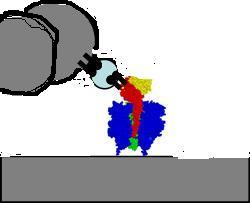|
|
For over 20 years the bacterial flagellar motor was the only known living "wheel". Recently, however, it has been shown that F1Fo-ATPase (also known as ATP-synthase) contains two more rotary motors [1]. ATP is the energy source for most metabolic reactions in living things, and most of it is made from a transmembrane protonmotive force by ATP-synthase. So this is a very important molecular machine. A typical human will synthesise and use up his/her own bodyweight in ATP in a day. The purpose of the F1Fo-ATPase is to couple ATP hydrolysis in F1 to proton flux across the membrane in Fo, and rotary motion is a means to this end rather than an end in itself. Nonetheless, the complex can be considered as two reversible rotary motors connected “back-to-back” by a common rotor, such that rotation of Fo driven by proton flux leads to ATP production in F1, while ATP hydrolysis in F1 drives the rotor in the opposite direction and leads to proton pumping in Fo.
Rotation of F1 driven by ATP hydrolysis has been observed directly by sticking the outer subunits to a coverslip and attaching fluorescent actin filaments or sub-micron gold beads to the central subunit [2]. We stick pairs of polystyrene beads, 300-500 nm in diameter, to the gamma subunit of F1 and measure their rotation. We use F1 from E. coli, engineered by the lab of Masamitsu Futai in Tokyo, or from yeast, engineered by the lab of David Mueller in Chicago. We control the angle of the beads with an optical tweezers [3-5] that has software programmable feedback [6]. We aim to measure in detail the torque generated by F1 at different angles and in different states, and to relate the structure and function of yeast F1 mutants.
This is a relatively new area for the lab, but we have a growing sub-group working on ATP-synthase.
References
1. Junge, W., Lill, H. an Englebrecht, S. (1997). ATP synthase: An electro-chemical transducer with rotary mechanics. Trends Biochem. Sci. 22:420-423.
2. Noji, H., Yasuda, R., Yoshida, M., and Kinosita, K. (1997). Direct observation of the rotation of F1-ATPase. Nature 386, 299-302.
3. Berry, R.M., and H.C. Berg. 1997. Absence of a barrier to backwards rotation of the bacterial flagellar motor demonstrated with optical tweezers. Proc. Natl. Acad. Sci. USA. 94:14433-14437.
4. Svoboda, K., Schmidt, C. F., Schnapp, B. J. and Block, S. M. 1993. Direct observation of kinesin stepping by optical trapping interferometry. Nature 365:721-727
5. Finer, J.T., Simmons, R.M. and Spudich, J.A. 1994. Single myosin molecules mechanics: piconewton forces and nanometre steps. Nature 368:113-119.
6. Pilizota T, Bilyard T, Bai F, Futai M, Hosokawa H, Berry RM. (2007). A programmable optical angle clamp for rotary molecular motors. Biophys. J. 93:264-275.
last updated: 26 August 2008

